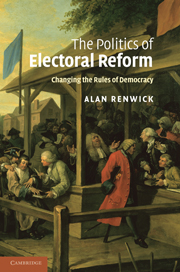Book contents
- Frontmatter
- Contents
- List of tables
- List of figures
- List of abbreviations
- Acknowledgements
- 1 Introduction
- PART I Building blocks
- 2 What motivates actors?
- 3 From motivations to outcomes: exogenous factors
- 4 The reform process: endogenous factors
- PART II Elite majority imposition
- PART III Elite–mass interaction
- Appendix: glossary of electoral system terminology
- Bibliography
- Index
3 - From motivations to outcomes: exogenous factors
Published online by Cambridge University Press: 04 May 2010
- Frontmatter
- Contents
- List of tables
- List of figures
- List of abbreviations
- Acknowledgements
- 1 Introduction
- PART I Building blocks
- 2 What motivates actors?
- 3 From motivations to outcomes: exogenous factors
- 4 The reform process: endogenous factors
- PART II Elite majority imposition
- PART III Elite–mass interaction
- Appendix: glossary of electoral system terminology
- Bibliography
- Index
Summary
The previous chapter provided the first building block for understanding processes of electoral reform: a wide overview of the power interests and values that actors may pursue. The next stage is to explore the key steps through which these potential motivations come together and translate into electoral system outcomes. I distinguish three such steps. The first concerns the processes that shape particular actors' motivations: of the many considerations laid out in Chapter 2, which do particular actors in fact focus on and what determines the weights they give them? The second relates to the mechanisms through which these motivations translate into specific preferences over the many available courses of action. Here we must consider both which option is objectively best given actors' goals and what constraints their perceptions are subject to. The third addresses how these preferences translate into outcomes.
I begin the task of analysing these mechanisms in the present chapter by considering factors exogenous to the reform process. I pursue it further in Chapter 4 by analysing the internal dynamics of the reform process, focusing especially on leadership and path dependence.
In analysing the three steps in this chapter, I invoke six categories of explanatory factor: history, ideational change, the nature of parties and the party system, state institutions, events and circumstances, and the nature of actors. Most of these are relevant to both the first and second stages. With regard to the third stage, I focus more narrowly upon the role of institutions.
- Type
- Chapter
- Information
- The Politics of Electoral ReformChanging the Rules of Democracy, pp. 47 - 68Publisher: Cambridge University PressPrint publication year: 2010



